NCERT Exemplar Class 10 Science Chapter 11 Human Eye and Colourful World are part of NCERT Exemplar Class 10 Science . Here we have given NCERT Exemplar Class 10 Science Chapter 11 Human Eye and Colourful World.
NCERT Exemplar Class 10 Science Chapter 11 Human Eye and Colourful World
Short Answer Questions
Question 1. A student sitting at the back of the classroom cannot read clearly the letters written on the blackboard. What advice will a doctor give to her? Draw ray diagram for the correction of this defect.
Answer.
The student is suffering from short-sightedness. Doctor will advise to her to wear a concave lens having suitable power for correcting the vision.

Question 2. How are we able to see nearby as well as the distant objects clearly?
Answer.
Accommodation: The ability of the ciliary muscles to adjust the curvature and thereby the focal length to get clear view of objects is called accommodation. There is always a limit up to which ciliary muscles can increase or decrease the focal length of eye lens. This change enables us to see nearer and far-off objects clearly.
Question 3. A person needs a lens of power – 4.5 D for correction of her vision.
(a) What kind of defect in vision is she suffering from?
(b) What is the focal length of the corrective lens?
(c) What is the nature of the corrective lens?
Answer.
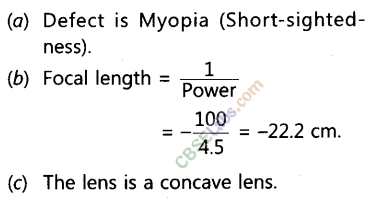
Question 4. How will you use two identical prisms so that a narrow beam of white light incident on one prism emerges out of the second prism as white light? Draw the diagram.
Answer.
Consider a prism A. When white light falls on it, it splits into seven constituent colours. The violet colour deviates the most and red colour deviates the least, as shown.
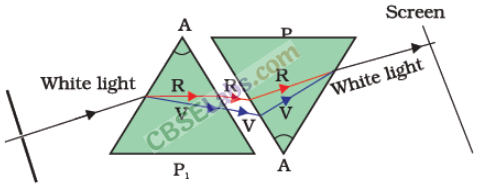
If another prism B is placed such that they are as shown below, the light that emerges out of A will be made to merge together to come out as white light.
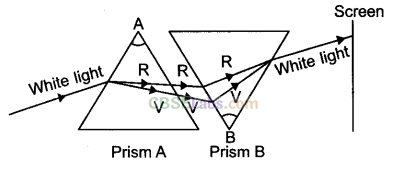 >
>
Question 5. Is the position of a star as seen by us its true position? Justify your answer.
Answer.
Light from stars passing through the atmosphere, bends due to changing refractive index of different layers of the atmosphere and appears as if it comes from a higher level than they are actually. So, the stars appear slightly higher than the actual position.
Long Answer Questions
Question 6. Explain the structure and functioning of Human eye. How are we able to see nearby as well as distant objects?
Answer.
Human Eye:
The natural optical device through which one could see objects around him. It forms an inverted and real image on a light sensitive surface called the retina.
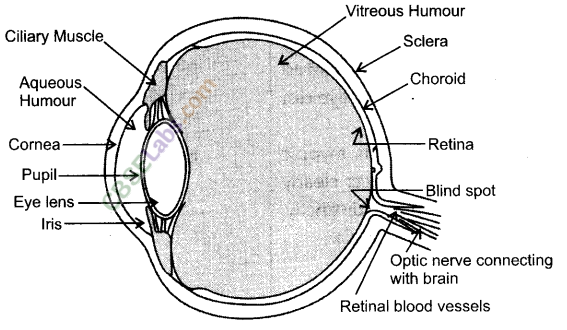
Parts of human eye are:
- Iris: It is a dark muscular diaphragm that controls the size of the pupil.
- Pupil: The black opening between the aqueous humour and the lens. Since, light does not get reflected from it, so its appearance is dark. The amount of light entering the eye is controlled by the size of the pupil. In dim light, it opens up completely through the iris, but in bright light, it becomes very small. •
- Cornea and Aqueous Humour: Acting as lens, they provide the refraction for light rays entering the eye. Cornea is a thin membrane covering the surface of eyeball, through which light enters. Aqueous humour is a transparent gelatinous fluid filled between cornea and eye-lens.
- Ciliary Muscles: These muscles hold the eye lens in vertical position and change the focal length of eye lens to form the sharp image of objects located at different distances on the retina.
- Retina: The light sensitive surface of eye on which image is formed. It is equivalent of the photographic film in a camera. It contains rods and cones.
- Rods and Cones: The cells in retina, which are light and colour sensitive. Rods respond to the intensity of light. Cones respond to the colour. There are around 125 million rods and cones. The cells generate signals which are transmitted to the brain through optical nerves. The brain process the information via these electric signals and give the impression of erect image to us.
To see nearby as well as distant objects, ciliary muscles modify the curvature of eye lens. This leads to variation in focal length. When the muscles are relaxed, the focal length of the lens has its maximum value, equal to the distance from the retina. So, parallel rays coming into the eye get focussed on the retina. When the eye looks at nearby objects, the ciliary muscles are strained and the focal length decreases. So, that sharp image again forms on the retina.
Question 7. When do we consider a person to be myopic or hypermetropic? Explain using diagrams how the defects associated with myopic and hypermetropic eye can be corrected?
Answer.
A person can be considered as myopic when he can see nearby objects clearly but cannot see distant objects distinctly. This defect of eye is called myopia.
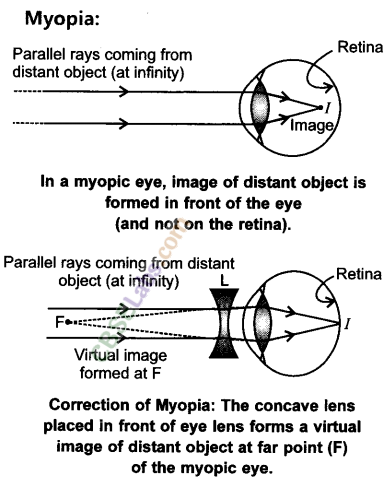
When the person cannot see nearby objects clearly but able to see distant objects clearly, the person can be treated as hypermetropic. The eye defect is called hypermetropia.
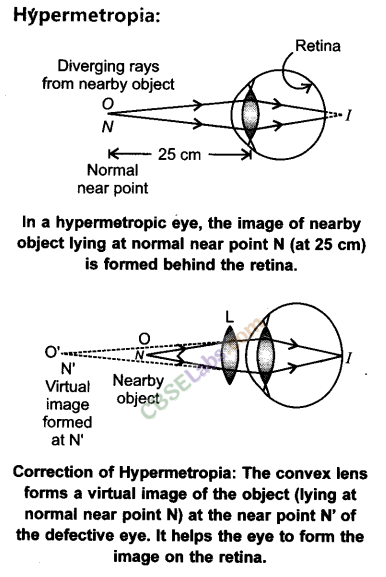
NCERT Exemplar Class 10 Science Solutions
- Chapter 1 Chemical Reactions and Equations
- Chapter 2 Acids Bases and Salts
- Chapter 3 Metals and Non-metals
- Chapter 4 Carbon and its Compounds
- Chapter 5 Periodic Classification of Elements
- Chapter 6 Life Processes
- Chapter 7 Control and Coordination
- Chapter 8 How do Organisms Reproduce
- Chapter 9 Heredity and Evolution
- Chapter 10 Light Reflection and Refraction
- Chapter 11 Human Eye and Colourful World
- Chapter 12 Electricity
- Chapter 13 Magnetic Effects of Electric Current
- Chapter 14 Sources of Energy
- Chapter 15 Our Environment
- Chapter 16 Management of Natural Resources